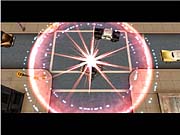Freedom Force Designer Diary #8
3D artist Anthony Clare describes the process of creating special effects for Freedom Force.
Entry #8 - 08/27/01
By Anthony Clare
3D Artist, Irrational Games
Hi all. My name is Anthony "Abbadon" Clare, and I am a 3D artist here in the Canberra, Australia, office of Irrational Games. I started about 13 months ago, and after working on some of the usual game assets, I was asked if I would like to do effects for Freedom Force. Being a twit, I smiled and said yes. I have been the effects monkey here on the UNN Elouera Lonsdale ever since. A constant supply of bananas, chips, and Coke has enabled me to work through the 60-odd characters and character-state effects. Today I want to give you a little insight into how we have approached the effects creation tasks on Freedom Force.

One of the duties in my job description was to help develop and maintain an art aesthetic for the game. In relation to the effects, this was where we had to try to take all the blams and pows and spangles and zaps from the pages of Silver Age comics and place them in the environment that our characters inhabit. Unlike in the comics, this environment is fully 3D. But like in the comics, the characters in this world have abilities, which means that they can do (just about) anything. And not only did we have to try to carry over the feel of the comics, but we also had to stay true to the game design and what it needed to make the game a "game"--that is, fun. These are some tough constraints to work in, but after a lot of experimentation, we found that the bigger, bolder, and brighter effects really stood out and that a combination of 2D and 3D elements as well as particle systems best achieved a re-creation of the comic look in the 3D world.
Staying within the tech specs while also achieving the designers' vision is a pretty intense task. What's proved to be important is maintaining the right balance of particle systems, polygonal elements, 2D elements, and textures. The various effects use these "ingredients" in differing proportions. Words such as the classic "Pow!!" and "Zaaaaaaaap!!!" are included where appropriate. These are on billboards so as to always face the camera. I use the polygonal elements to morph a shape for animation and/or to give volume to an effect. Particle systems give a different type of animation to the effects and can give a sense of force and movement without spending hours hand-animating hundreds of individual elements. Lastly, but perhaps most importantly, are the textures. Without them the effects would be a rather frightful display of colored squares and triangles popping across the screen. So a critical part of making the effects is doing the textures for them. As in all texturing jobs, not only do you have to watch your in-game texture budget, but you also have to keep in mind naming conventions and the disk space the textures will take up.
Apart from getting the look right, we always have to deal with the technical issues involved. This meant that I had to spend more time with the programmers--nah, they are a great bunch of guys...really. That aside, tackling the technical issues gave me a much better idea of what the technology was capable of and also what the limitations were. Working within (harsh) limitations is one of the things that an artist in game development has to deal with. You might make an awesome particle-effect explosion in 3D Studio MAX, but regardless of how great it looks in a render, the chances of it getting into the game (on current platforms) are dependent on many technical factors. You always have to walk the line between the art and the frame rate. Sure, it's important for it to look great, but if it drops the frame rate, it's not acceptable.

To the right is an example of the "right" mix of elements that we've settled on. Note the use of particle systems, 2D "billboard" elements, and 3D elements. It's impossible to fully do justice to these effects in a static screenshot, but hopefully you can get some idea of our direction.
Creating the effects for the superpowers is just one aspect of my duties and responsibilities. There are other instances during cutscenes when effects are practically all that is really onscreen. It is during these times that we can push the budget a little and squeeze some more particles and polygons into the effects. Some of the cutscene sequences go for 10 seconds or more and require careful planning, with the designers putting together the scene to get it right. Another aspect of my work is the world effects. There is a whole environment that needs to feel alive. There are explosions, burning torches and cars, fountains, birds, and flags that need to be animated to help suspend the disbelief for the player. A scattering of these elements around the levels really helps things come to life.
All in all, we have heaps to keep us busy! It hasn't all been effects for me though. Recently, I got to have a little break and model and texture some characters for the game. This enabled me to look at the game from another point of view and helped to tie up the individual art assets and see the overall vision for the game aesthetic. As it stands, we are pretty specialized in the art pit, so it's very helpful to occasionally get a wider view of everything.
I hope I've managed to give you a short overview of how we are going about creating the effects for Freedom Force. Stay tuned for more updates soon!
Got a news tip or want to contact us directly? Email news@gamespot.com
Join the conversation